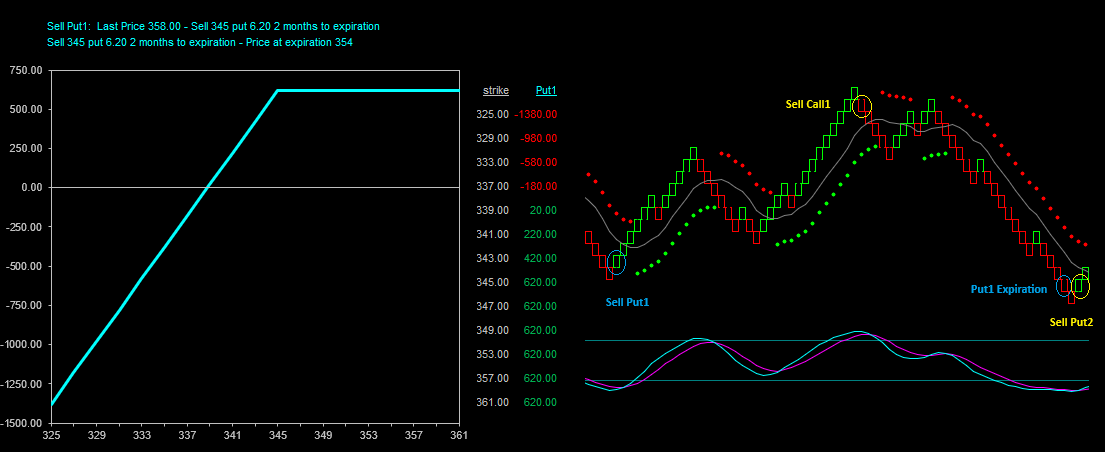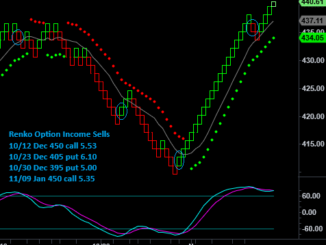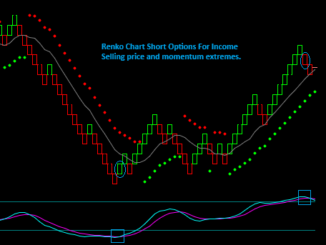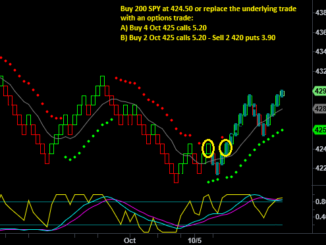Renko options selling strategies have several key factors that affect trading:
- What happens with short options at expiration?
- Do you have a margin account with sufficient assets to make your trades?
- Has the brokerage approved your account for selling uncovered options?
If you qualify to sell uncovered options, you must understand the assignment and exercise procedures for options.
Can someone exercise your short options before their expiration? What if you are short in the money options at expiration and have an underlying position assigned to you?
Margin Account And Options Selling Approval
You will sell Renko options in a margin account. A margin account for short selling allows traders to sell options [or equities] that they do not own.
The brokerage uses your margin account as a safeguard to ensure you can cover potential losses. The broker will require you to maintain a certain amount of equity as collateral.
You must have approval in your margin account for the short options trades you wish to execute.
You will find the approval requirements from your broker. Essentially, you will find that the approval and account size for selling uncovered puts and put or call credit spreads is less stringent than for selling uncovered calls.
|
Margin Per The CBOE “In the options market, “margin” also means the cash or securities required to be deposited by an option writer with his brokerage firm as collateral for the writer’s obligation on a short option (i.e., to buy or sell the underlying interest, or in the case of cash-settled options to pay the cash settlement amount), if assigned an exercise. Uncovered writers may have to meet calls for substantial additional margin in the event of adverse market movements. Even if a writer has enough equity in his account to avoid a margin call, increased margin requirements on his option positions will make that equity unavailable for other purposes.” https://www.cboe.com/us/options/strategy_based_margin/ Options Clearing Corporation Also, look at the OCC’s Characteristics and Risk of Standardized Options document. You can download a PDF that was updated on March 30, 2023 https://www.theocc.com/Company-Information/Documents-and-Archives/Options-Disclosure-Document |
Short Uncovered Call
Why is selling uncovered [naked] calls such an issue?
The premise is your loss is unlimited because there is no limit to how high the underlying can go. So, it’s not an actual limit; a stock will not go up forever. The issue probably comes from shorting a stock that becomes bought out.
Selling calls on an ETF like the SPY and QQQ does not buy out risk. I do not use Renko options selling strategies for shorting stock calls. Although I think it would be safe to use sell calls on a stock like APPL or MSFT.
If you cannot attain uncovered call selling approval, you will adjust your Renko options selling trades:
- Instead of selling a naked call for income, you will sell a call credit spread.
- Instead of selling a naked call as part of a synthetic options short trade [long put-short call], you will only buy puts or anchor your short call with a long call in a spread.
You will check with your brokerage for specific margin requirements, but here are the requirements from Interactive Brokers:
Call Price + (15% * Underlying Price) – Out of the Money Amount
- You would use 20% of the underlying price for equity options to determine the margin.
Sell 1 QQQ 380 call for 5.00 when the QQQ = 365.00
- = 5.00 + (.15 *365) – 15
- = 5 + 54.75 – 15
- = 44.75 * 100 = 4475
Brokers differ in their approach to the short sale premium; Interactive Brokers state that they apply short sales proceeds to cash. So, in that case, the margin requirement would be:
- 4475 – 500 = 3975
Note that the margin requirement for the trade does not include the account size and assets needed to sell uncovered options, especially calls.
What Happens To Short Options At Expiration
Our Renko options selling strategies use short options in 2 ways: (1) selling options, typically longer term and out of the money, for income, and (2) combining short options with a long option to create a synthetic underlying.
And there will be times when these short options are still open approaching expiration or even on expiration day. This leads to 2 questions:
- Can someone exercise your short options before their expiration?
- What happens to a short option when it expires?
Firstly, the holder can exercise their SPY QQQ long options before they expire. Typically, traders don’t exercise ETF options early because selling the option for its time value yields a higher profit.
However, there can be times when early exercise benefits the option owner. The deeper an option goes in the money, the less liquid it becomes, and the bid-ask spread tends to widen out. When this happens, instead of trying to sell the option, the buyer can exercise it and then sell the underlying.
And if that occurs, you, as the option seller, have a short position on the underlying at the option’s strike price.
Short Options At Expiration
The option buyer has the right to exercise their options early. They do not have to be in the money. But your assignment is automatic at expiration for in the money options.
- Short Calls: If the underlying price is above the strike price, the option is ITM. When the buyer exercises their option, the seller must sell the ‘asset’ at the strike price.
- Short puts: If the underlying price is below the strike price, the option is ITM. When the buyer exercises their option, the seller must buy the ‘asset’ at the strike price.
Options that are out of the money at expiration expire worthless. This is the objective for the Renko options selling strategies.
Assignment of short options gives you a long or short position in the underlying. You will receive a margin call if you do not have the necessary funds in your account to support these positions. Then, if you do not meet the margin call, you can have the position liquidated.
The liquidation will occur regardless of the size of the loss and without the opportunity to keep and manage the assigned position.
Our Renko options selling strategies do not want these positions due to assignment. If we are going to do a trade, it is because we have a Renko long or short trade setup.
Avoid early exercise by monitoring and closing your short options when they get deep in the money and lose time value and liquidity. And avoid short option expiration assignments unless, for some reason, you want the new position and have the necessary account size.
Renko Options Selling And Expiration
For instance, look at the profit graph and chart below for the blue circle labeled Sell Put1. Your strategy is Renko options trading for income. For this trade, you will sell a 345 put for 6.20 when the underlying is at 358.00, and there are 2 months to expiration.
The profit graph for your short put options shows the horizontal line, which is your maximum profit for selling the put = 6.20. The diagonal line first shows the decrease in profit from its maximum at the strike to its breakeven point. Then, the diagonal line shows the loss as the underlying continues down.
Click On The Chart To See Full Size
Question: You sold the 345 put when the last price was 358.00, and blue circle2 shows the expiration price 354.00. If the underlying price at expiration is lower than the price you sold the put, will someone exercise your short put?
No. Assignment has nothing to do with the underlying price when you sell your option. If the put expires below 345, the option buyer assigns you at the short option strike price.
Also, recognize that assignment can occur regardless of the profitability of your short option. The option buyer will assign your 345 put if the expiration price is 344.90, but you still have a 6.10 profit.
Renko Short Option Management
Manage your short options trades; close them before expiration if they are in the money.
Look at the chart and yellow circle1 labeled Sell Call1 regarding this particular trade. I have a Renko option selling setup for shorting a call:
- Slow momentum has become extreme.
- There is a counter direction brick.
- This is my same Renko option trade setup for selling Put1.
But at this point, the price for the short put has gone from 6.20 to .35, and there is still a month to expiration.
You have made almost 95% of the potential profit. Close the short option and recapture the margin for selling the put; the risk-reward for holding this put is very poor.
Short Strangle – Sell Put-Sell Call
Like short Put1, you can close short Call1 for around 95% of its potential profit. Closing the trade would be good management.
When you look at the profit graph before closing the short call, you see the combined profit and loss of both a short call and a short put. Your position is a short strangle.
The short strangle is typical of the Renko options selling positions, where you sell puts and calls together for income.
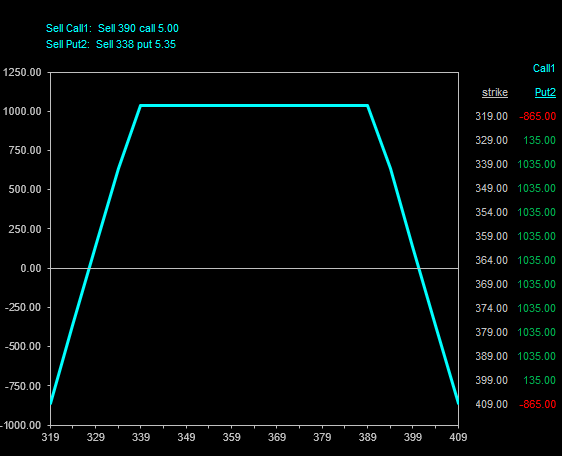
You can see that the short strangle has its maximum profit when the underlying price at options expiration is between the 2 short option strikes. A beneficial aspect of the profit curvature at expiration is a potential assignment on only the call or the put. It would not be possible for both of these short options to be in the money.
Understanding the assignment risk for Renko options selling is essential for effective trading. Be aware of potential scenarios and risks, and protect against expiration assignments.

